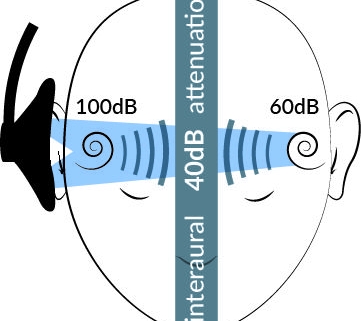What are attenuators?
Attenuators are electrical components designed to reduce the amplitude of a signal passing through the component, without significantly degrading the integrity of that signal. They are used in RF and optical applications. RF attenuators are generally used in electronic circuitry, while optical ones are used in fiber optics. There are essentially six different kinds of RF designs: fixed, step, continuously variable, programmable, dc bias and dc blocking.
Key specifications of an attenuator to consider include the attenuation measured in decibels (dB), frequency range (MHz), power handling (W), and impedance (Ohms).
Fixed attenuators

There are three basic unbalanced attenuator configurations: L, Tee, and Pi. The balanced configuration of the Tee and Pi are H and O respectively. Balanced configurations are symmetrical resistive networks while unbalanced are asymmetrical.
Attenuators typically consist of a resistive network that allows heat to dissipate at a certain rate. There are a few basic layouts—the “T” configuration, the “L” configuration and the “pi” configuration. These established layouts already have set equations and resistor values that can be used to yield the characteristic impedance (Z0) across a range of frequencies, and are also known as unbalanced attenuators with asymmetrical circuits. The balanced or symmetrical circuit, version of the “T” attenuator, is known as the “H” configuration, and the balanced version of the Pi attenuator, is known as the “O” configuration.
Fixed attenuators are set at a fixed and unchanging attenuation by these resistive networks. They are placed in signal paths to decrease power transmitted. They can be surface mount, waveguide or coaxial types. Depending on the application, an attenuator can be directional or bidirectional. A signal can only go from input to output in a directional attenuator and can travel both ways in a bidirectional attenuator. For a chip-based attenuator, a resistance is developed through various materials deposited onto a thermally conductive substrate, and depending on the process—thick film or thin film—the physical dimensions and the material used will all yield a particular resistance value. A continuous variable attenuator resistance can also be achieved by arranging an assembly of resistive rods and resistive discs; still, many are built using chips.
Step attenuator

Depending on the application, an attenuator can be in chip, waveguide or coaxial formats.
Step attenuators are fundamentally fixed attenuators, as they are still passive components that comprise various resistive networks to generate a particular attenuation. The attenuation value can be selected based upon a manual push-button, or the spin of a rotary switch. Step attenuators, unlike variable attenuators, can only generate an attenuation value based on pre-allocated steps. For example, a push-button step attenuator can go from 0 to 45.5 dB and, depending on the arrangement of the buttons, can be increase in increments of 0.5 dB.
Continuously variable attenuators
Continuously variable attenuators can be adjusted manually to yield any attenuation value within a specified range and resolution. In an active continuously variable attenuator, the resistor networks that are in fixed attenuators and step attenuators have been replaced with solid-state elements such as metal oxide semiconductor field effect transistors (MOSFETs) or PIN diodes. A particular attenuation can be varied with greater resolution by controlling the voltage across the FET or current across the diode, than with passive resistive networks. The attenuation can be controlled manually or electronically with a motor to maintain a particular attenuation.
Programmable attenuator
The programmable attenuator, also known as a digital step attenuator, is a component controlled by an external voltage. This external control is generally computer-driven. They are often controlled by transistor-transistor logic (TTL) inputs, and the step sizes are typically 1, 2, 4, 8, 16, and 32. The TTL controlled attenuators have a logic level of ‘0’ when the voltage applied at a particular attenuator is less than 1 V, and a logic level of ‘1’ when the voltage applied is typically 3 V or higher. These logic levels control single-pole, double-throw (SPDT) switches that connect the various attenuators in a signal path that yields a desirable attenuation. In the realm of programmable attenuators, there are also USB controlled designs to simplify the mating from attenuator to computer. Often, they are packaged with established software, to have readily enabled control of the device.
Dc passing attenuator
DC bias attenuators also known as dc bias passing attenuators, passes dc while also attenuating the RF signal. They generally have a capacitance on the input and output of the attenuator that blocks dc from passing over it, but allows the RF signal to pass—the dc signal bypasses the attenuator through another path to the output.
Dc blocking attenuators
DC blocking attenuators are similar to dc bias designs in that they block the dc signal; the difference is that the dc is completely blocked without an outlet going to the output of the component. The dc block can be placed in series with the center conductor, also known as an “inner dc block”—it can also be placed in series with the outer conductor, which is known as an “outer dc block.” There are also dc blocking attenuators with both the inner and outer dc blocks.
Waveguide attenuators

Attenuators that can yield a variety of values will typically use some form of switching (SPDT) to vary a signal path and yield a desired attenuation. Continuously variable attenuators leverage solid state components to allow for very minute adjustments in an attenuation range.
Waveguide attenuators will attenuate an RF signal in a waveguide system; this is typically accomplished by affixing a resistive film at the center of the waveguide. A continuously variable waveguide attenuator typically uses a screw to adjust this resistive material from one side of the waveguide wall to the center; in this case, the resistive material is shaped to yield a linear variation in attenuation. Some waveguide designs allow the user to input a value manually, using a dial, to obtain a specific attenuation. This simplifies the process by cutting out the step of adjusting the screw in a continuously variable waveguide attenuator and having to measure the attenuation until the desired value is reached.
Optical attenuators
Optical attenuators attenuate light waves instead of electron waves so this attenuator typically functions as a component that absorbs or dissipates light. Similar to RF designs, there are several kinds of optical designs specifically designed for an application. Fixed optical attenuators typically leverage doped fibers or offset splices to disperse the light. Variable optical attenuators are similar to RF variable attenuators and programmable step attenuators, in that they can be manually or electronically controlled to yield a specific attenuation.
From:http://www.hj-antenna.com/




Leave a Reply
Want to join the discussion?Feel free to contribute!